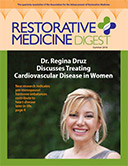The term senolytic first appeared in the research literature in 2015 to describe substances that selectively kill senescent cells and leave normal cells intact. Senescent cells are known to play a pivotal role in the aging process because their increasing accumulation in tissues and organs promotes inflammation and cellular dysfunction. As a consequence, senescent cells are implicated in the onset and progression of several aging-related health conditions such as cancer, diabetes, cardiovascular disease, and dementia. A number of natural compounds, including quercetin,1 curcumin, and fisetin2 have demonstrated senolytic effects.
Fisetin is a flavonoid polyphenol found in a variety of fruits and vegetables including strawberries, apples, mangoes, grapes, persimmons, kiwis, tomatoes, cucumbers, and onions. Preclinical studies indicate that fisetin has neurotrophic, cardioprotective, anti-inflammatory, antioxidant, and anticarcinogenic effects.3,4 It has been shown to be neuroprotective in animal models of aging-associated neurological disorders such as Huntington’s disease,5 as well as in ischemic stroke.6,7
In one study, fisetin was shown to activate signaling pathways for neurotrophic factors, and to enhance long-term memory formation in mice.8
Fisetin is one of a few naturally derived senolytic agents that has been shown, in animal models of aging, not only to reduce the number of senescent cells in tissues but also to extend lifespan. The mechanism of action for lifespan extension likely involves inhibition of the mTOR pathway.9Animal studies suggest that even administering fisetin later in life will potentially restore tissue homeostasis, decrease aging-related pathology, and extend lifespan.10
In an animal model of early-onset (familial) Alzheimer’s disease, fisetin prevented the development of cognitive and memory impairments. This effect correlated with decreased markers of oxidative stress in brain tissue, along with reductions in levels of proteins that cause neuroinflammation and neurodegeneration. The effects of fisetin were also associated with global improvements in inflammation, pointing to its potential benefits for overall health as well as brain health, given the link between inflammation and aging.11 In addition, fisetin helped modulate proteins involved in synaptic function. This is significant because there is some evidence to suggest that Alzheimer’s disease is a synaptic disorder, and that the number of neocortical synapses correlates more accurately with cognitive health than beta amyloid plaques or neurofibrillary tangles.12
Age rather than genetic mutations is the greatest risk factor for Alzheimer’s disease,13 with familial Alzheimer’s disease accounting for less than 1% of all cases.14 The researchers who studied fisetin and familial Alzheimer’s disease then went on to examine the effects of fisetin in mice genetically engineered to age rapidly and develop the equivalent of late-onset (sporadic) Alzheimer’s disease, which is the most common age-associated form. In this study, three-month-old mice were divided into two groups: a control group and a treatment group that was given fisetin in their food every day for seven months. Mice fed fisetin had improved cognitive and motor function when compared to controls. In fact, the cognitive function of treated mice was comparable to that of three-month-old mice. In addition, hippocampal tissue of mice fed fisetin had lower levels of inflammatory markers when compared to the control group.15
Interestingly, fisetin has been shown to greatly increase levels of the omega-3 fatty acid DHA (docosahexaenoic acid), a primary structural component of the human brain, possibly by reducing DHA oxidation. Low plasma levels of DHA, as seen in the elderly and patients with Alzheimer’s disease, correlate with cognitive decline. By contrast, DHA supplementation and higher plasma levels are associated with a lower risk for Alzheimer’s disease.16
Evidence continues to mount in support of fisetin as a beneficial modulator of several key pathways linked to cognitive decline and other dysfunctions associated with aging. Clinicians may want to advise patients about supplementation and dietary sources of fisetin, as part of an overall plan to prevent or mitigate age-related dysfunction and to promote a healthy life span.
References
- https://pubmed.ncbi.nlm.nih.gov/31542391/
- https://pubmed.ncbi.nlm.nih.gov/31077707/
- https://pubmed.ncbi.nlm.nih.gov/27671819/
- https://www.ncbi.nlm.nih.gov/pmc/articles/PMC3689181/
- https://pubmed.ncbi.nlm.nih.gov/20952447/
- https://pubmed.ncbi.nlm.nih.gov/17765210/
- https://pubmed.ncbi.nlm.nih.gov/22234339/
- https://pubmed.ncbi.nlm.nih.gov/17050681/
- https://www.ncbi.nlm.nih.gov/pmc/articles/PMC8416555/
- https://www.ncbi.nlm.nih.gov/pmc/articles/PMC6197652/
- https://pubmed.ncbi.nlm.nih.gov/24341874/
- https://pubmed.ncbi.nlm.nih.gov/25231068/
- https://pubmed.ncbi.nlm.nih.gov/26007212/
- https://pubmed.ncbi.nlm.nih.gov/16876913/
- https://academic.oup.com/biomedgerontology/article/73/3/299/3860587?login=true
- https://pubmed.ncbi.nlm.nih.gov/20088810/
